Quests
This is an excerpt from Using Literature in the Middle School Curriculum by Carol Otis Hurst and Rebecca Otis (Linworth Publishing, 1999. ISBN 0938865730. Purchase online.)
This theme could include almost every work of fiction and many works of nonfiction listed elsewhere in this book. It crosses genre and is intended to allow students to follow their own interests in reading but find means of commonality among their choices. Leland Jacobs defined story as "one or more characters on a quest". Exploring that concept with readers may show them another way of looking at and analyzing books. It can also provide an outline for writing their own stories.
Finding the characters and defining their quests is usually the easy part. In most stories the quest is stated somewhere early in the text. In some, however, the quest is implied.
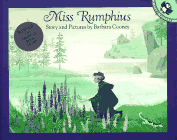
Picture Book Starter
Barbara Cooney's beautiful picture book Miss Rumphius (Puffin, 1985 ISBN 0140505393. Paperback. Library Binding. Cassette.) is one that many of your students will have encountered in grade school but it's beauty and meaning may have eluded them then. Now they can enjoy the illustrations and the story of a woman determined to fulfill her quest, actually multiple quests, before her life is complete.
Activities
The story of Miss Rumphius may lead students to discuss or even just think about their own personal goals and ambitions. Making the world more beautiful is also a subject worthy of discussion from the book and students can make up a list of ways in which they could accomplish this quest soon.
The character or characters on the quest are not always successful. Sometimes they just plain fail, usually learning something on the way. Other times they fail to achieve the original objective but get something else instead. Sometimes they achieve their aim but are unaware of it. Other times they think they achieve their goal but do not really do so. Sometimes more than one quest is going on at the same time by various characters in the book. Occasionally the goal can only be achieved by one and others are thus thwarted in their quest. In other books and stories, disparate characters join in a common search. Students can start categorizing familiar stories along those lines.

In Tom Sawyer (ISBN 0140390839. Paperback. Hardcover. Cassette. Large Print.) Aunt Polly's quest is to raise Tom to be a respected member of society. Tom's quest is to outwit Aunt Polly, run free and explore the world. Huck's quest is to retain his freedom. These might be represented graphically in this way:
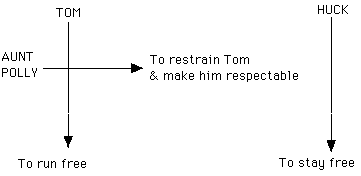
The diagram shows that, if Tom gets his way, Aunt Polly can't get hers but Huck's quest is independent of both of them. Since Tom Sawyer is episodic, many chapters can be seen as individual quests. For instance, in "The Glorious Whitewasher" there are several quests which can be defined and plotted in different ways:
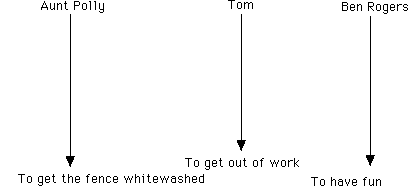
If we define Aunt Polly's quest in this way, everybody is a winner. If, on the other hand, we define Aunt Polly's quest as "to punish Tom", the result and the diagram is different:
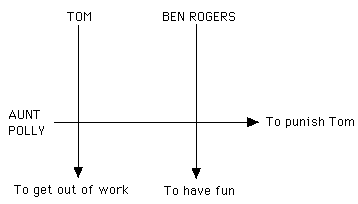
In this set up, Aunt Polly's quest and Tom's are at cross-purposes. If she is successful, Tom is not and vice versa. Since Ben's quest and Tom's are parallel, they can both be winners.
Carrying the quest analysis further, if a character in a story sets out on a quest and the story simply tells how he or she did it, the story is apt to be boring. Most writers put in barriers, abettors and interveners to make the plot less simplistic and more interesting. They can be identified in a diagram as well. In the diagram above, Aunt Polly is an intervener in Tom's quest. Ben Rogers is an abettor. Usually, but not always, abettors and interveners have their own quests which can be shown or ignored in a given diagram.
Looking at a novel or short story in this way can be an aid to thinking about the motivations of any and all characters within. Students may wish to show their stories content graphically in terms of quest in a form similar to this:
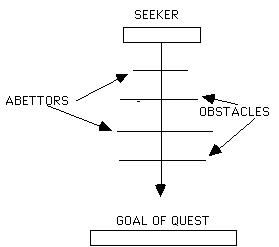
Charting a story along these lines could provide a new means of analysis. The same outline could serve as a way of setting up a story yet to be written. If students first conceive of a character and delineate that character with some descriptive phrases, they can then imagine what that character could conceivably want. By placing the character at the top of the page and the goal at the bottom, and deciding whether or not their character is going to be successful, they can then picture the story about to be written in terms of a quest. Deciding what obstacles the character will encounter and what characters and events will help that character, the writer can work with them on the page. The result could be a working outline for the story. Of course, there can and probably should be other characters with congruent or divergent quests so similar outlines could be developed for them. Some young authors might find writing easier after using such a setup.
This graphic analysis is not the only means of contrasting and comparing books about quests and journeys. The motivation behind the quest is worth discovering and discussing: Is it selfish? high-minded? a search for things material or otherwise? Are those undertaking the quests doing so willingly or under duress? Are the abetting or intervening characters well-developed or cardboard characters, there for a single purpose? Is the plot realistic? idealistic? fantastic? And, what happens as a result of the journey? Are people better off? Is the person on the quest better off?
Most fairy tales are quests of one sort or another. Snow White seeks refuge from her stepmother and a way to achieve adulthood on her own. Rapunzel seeks a rescuer from her cruel imprisonment. Jack seeks the treasures at the top of the beanstalk. Cinderella wants to go to the ball. Her abettor is the fairy godmother; her obstacles are the lack of costume and conveyance and the actions of her stepsisters and stepmother. Encourage students to make a similar quest analysis of different fairy and folk tales.
As with other themes in this book, the setting up and use of a chart may make the reading clearer and suggest opportunities for dialogue. The chart for quests may start like this
| Book | Questors | Quest | Abettors | Obstacles | Outcome |
| Hillgartner Colors in the Dreamweaver's Loom |
Zan | Prevent the taking of the territory of the Orathi. Resolve her own issues with her father. |
The twins The Dreamweaver |
Vernathi Khedathi |
Territory is secured Returns to face her father |
| Lowry The Giver |
Jonas | Become the Giver Save the twin Find out if there is an "Elsewhere" |
The Giver | The rules of his society | Unknown |
Students might, as a result of investigating the theme of quests in literature, choose to think about their own quests: do they have a goal? do they have long and short term goals? what are they doing to achieve them? See page xxx for ideas on getting students to investigate their time use in terms of goals.
Related Areas of Carol Hurst's Children's Literature Site
- Folk and Fairy Tales, Tongue-in-Cheek Versions. Featured Subject with activities, related books and links.
- Miss Rumphius by Barbara Cooney, book review
- Barbara Cooney, featured author
Related Areas on the Internet
Advertisement:
Advertisement:
Advertisement:

